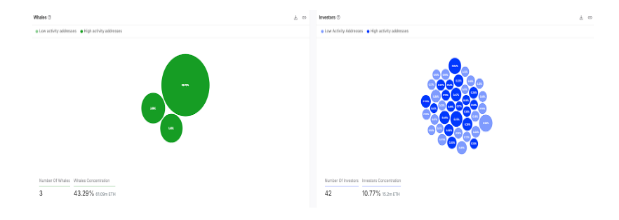This article is also available in Spanish.
Ethereum huge holders, also known as Ethereum whales, were on the right track accumulation trend have been around for some time, and on-chain data reveals a fascinating escalate in their collective holdings. In particular, data from a blockchain analytics company IntoTheBlock shows that Ethereum whales currently hold approximately 43% of the total ETH supply in circulation.
The imbalance in ETH wallets raises vital questions on this topic consequences for Ethereum price and market dynamics in the future.
Since the beginning of 2023, whale numbers have increased by over 90%.
According to IntoTheBlock, the total concentration of ETH in whale addresses is currently at 61.09 ETHwhich is approximately 43% of the total supply. This marks a significant change from early 2023, when whales held just 22% of Ethereum’s circulating supply. IntoTheBlock classifies whale addresses as those that hold more than 1% of the total ETH supply in circulation.
A noteworthy phenomenon is that Ethereum’s whale population has almost doubled in just one year. Naturally, such a concentration of a huge supply of cryptocurrencies in a few wallets would spell doom for the asset, as it would mean that a few players would be able to manipulate price dynamics as they see fit. However, the case of Ethereum deviates from this narrative due to the unique nature of its ecosystem and recent structural changes to the network since 2022.
The surge in whale concentration can be attributed to two main factors: Ethereum mergers and growing attractiveness Staking ETH to earn rewards. The Ethereum merger that took place in 2022 transformed the blockchain from a proof-of-work (PoW) system to a proof-of-stake (PoS) mechanism.
Therefore, the detailed data from IntoTheBlock, which shows 61.09 million ETH concentrated in just three whale addresses, makes sense.
This means that these ETHs are mostly those locked in the proof of stake staking algorithm used by block validators on the Ethereum network. By locking up their Ethereum, miners and huge ETH holders not only reduced the circulating supply, but also contributed to higher prices by reducing the quantity Etherum available for trading.
Ethereum Holder Dynamics – Investors and Retailers
The rise of ETH among whale addresses means that investors and retail owners have less ETH. IntoTheBlock classifies investors as addresses having between 0.1% and 1% of the total circulating supply, while retailers are addresses with less than 0.1% of the total circulating supply.
At the time of writing, there are 42 investor addresses who collectively hold 15.2 million ETH, representing 10.77% of the total circulating supply. Bearing in mind that the addresses of the three whales do not have a major impact on price dynamics, the addresses of investors are vital but more liquid portions ETH have a greater ability to influence market movements. Any significant sell-off at these investor addresses could cause the price of Ethereum to plummet.

On the other hand, retailers, who account for over 99% of ETH addresses, are left with 46% of the total supply in circulation. At the time of writing, Ethereum is trading at $3,225 and is down 2% in the last 24 hours.
Featured image from Pexels, chart from TradingView
